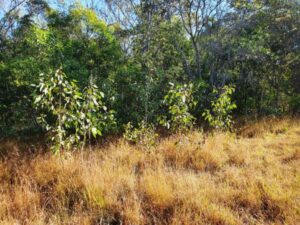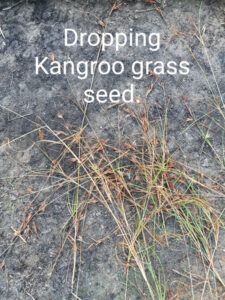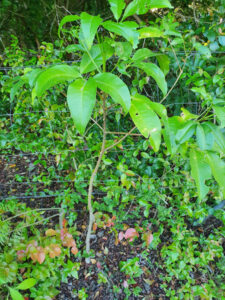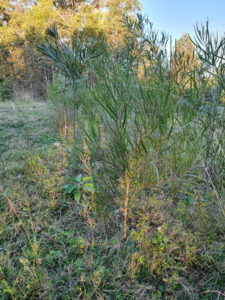Planting local native species in your garden is a big part of the UWG program. However there are other ways to encourage new plants.
The first way is to use a bush regeneration method of removing the weeds. Unless the soil in your garden has been severely disturbed or has been sprayed with herbicide continuously, there will be seeds lying there waiting for a chance to germinate. Simply removing the weeds exposes the soil to sun and moisture and the plants will grow. It will also encourage weed species to grow so correct identification is needed before pulling any out. A trip to your local native nursery will help to identify natives in the early stages of growth. (Keep an eye out for out our Nursery tour in the next few months.) The 3 leafed Melicope in the photo is an example of the effectiveness of this method. It took off after the Brazilian cherry was cut back.
The second way will sound good to the person who does the mowing, simply stop mowing. This won’t work in thick Buffalo lawn but is worth trying in less compact lawn grass. Try a small section first to see what comes through. An area close to native ground covers is best as they can then spread into that space. This will need a follow up weed to remove the lawn after the natives have established. The title photo shows trees that sprouted up in an area after the horses were excluded.
The third method works really well in a rural setting but can also be used in an urban garden. Disturbing the soil promotes seed germination. The first species that usually shows up is the Acacia (Wattle), often called the band aid plant. In the photo it can be seen growing close together along the side of the earthworks. This is a space where I was going to plant a hedge species but the Acacia has done the work for me. I will follow Shaun’s advice and keep the ones on the edge pruned and let the outside ones grow up. They will sort themselves out over time and I don’t except them all to thrive due to how close they are growing.
Spreading seed is the last method to consider when wanting more plants to establish in your garden. Simply cutting the seed off existing plants and throwing it on the ground can start germination. This is best done on recently disturbed soil but is worth trying on mulch or lawn. It’s a good way to encourage plants to grow in areas that are unsafe to work on such as steep slopes.
Plants that establish naturally are more likely to survive and thrive compared to the ones that we introduce, especially if bringing in mature plants. A little TLC with some water and weeding around emerging seedlings will help, or just sit back and let nature do its thing.






